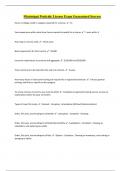Mississippi Pesticide License Exam Guaranteed Success
Hours of college credit in category required for a license. ✔️15
Years experience within what time frame required to qualify for a license. ✔️1 year within 3
How long is a license valid. ✔️Three years.
Bond requirement for Pest control. ✔️$5,000
Insurance required per occurrence and aggregate. ✔️$100,000 and $200,000
Time records are to be kept after the end of a contract. ✔️2 years
How many hours of classroom training are required for a registered technician. ✔️8 hours general
training, and 8 hours specific to the category.
To renew a license or permit, you must do what? ✔️Complete an approved training course, or pass an
examination within the past 12 months.
Types of insect life cycles. ✔️Gradual - Complete - Ametabolus (Without Metamorphosis)
Order, life cycle, and mouthparts of Beetles ✔️Coleoptera - Complete - Chewing
Order, life cycle, and mouthparts of Butterflies & Moths ✔️Lepidoptera - Complete - Chewing as
caterpillars, and siphoning as adults.
Order, life cycle, and mouthparts of flies. ✔️Diptera - Complete - Chewing as immatures, and sucking or
sponging as adults.
,Order, life cycle, and mouthparts of Ants, Bees, and Wasps. ✔️Hymenoptera - Complete - Chewing or
chewing and sucking
Order, life cycle, and mouthparts of true bugs, cicadas, leafhoppers, fulgorids, aphids, whiteflies, and
scales. ✔️Hemiptera - Gradual - Sucking
Order, life cycle, and mouthparts of Crickets and grasshoppers. ✔️Orthopetera - Gradual - Chewing
Stages of a gradual life cycle. ✔️Egg, nymph, and adult.
Stages of a complete life cycle. ✔️Egg, larva, pupa, and adult.
Stages of ametabolus life cycle. ✔️Young look just like adults in every way, just smaller.
Characteristics of Chewing mouthparts. ✔️Strong mandibles, smaller pair of maxillae.
Characteristics of Piercing/Sucking mouthparts. ✔️Elongate holo proboscis used to pierce plant, animal,
or insect being fed upon to suck up sap or blood.
Characteristics of mouthparts used for both Chewing and Sucking ✔️Chewing mandibles as well as
other mouthparts modified for sucking.
Characteristics of mouthparts used for Sponging ✔️Hollow proboscis with an enlarged sponge-like
structure.
Characteristics of mouthparts used for Siphoning ✔️Long hollow proboscis usually rolled up when not
in use.
A large order of insects having a single pair of wings, and sucking or piercing mouthparts. Describe
picture. ✔️Diptera (Flys)
, Leaf Miner - Describe picture, what they are, and how they feed. ✔️Various small moths or dipterous
flies whose larvae burrow into and feed on leaf tissue.
Describe picture and name of result of damage from an insect to the leaf of a plant. Insect is usually
gone. ✔️Leaf Gall
Crane Fly (Identify, life cycle, and food) ✔️Long-legged slender flies that resemble large mosquitoes but
do not bite. Complete life cycle. Feeds on grass roots, but adults do not feed.
Hymenoptera ✔️an order of insects including: bees
Cicada killer (Life cycle, food, and characteristic) ✔️large black or rust-colored wasp that preys on
cicadas, complete life cycle, largest wasp
Imported fire ant (Identify, life cycle, food, characteristics) ✔️Hymenoptera holometabolous chewing
pest, Complete life cycle, feeds on insects and seeds, has painful sting.
Orthoptera ✔️Order of grasshoppers, and crickets
House crickets ✔️nocturnal, live 2-3 months, lay 40 to 100 eggs
Field cricket (Identify, life cycle, characteristics) ✔️Common American black cricket. Gradual life cycle,
males use structures on their wings to produce songs.
Mole Cricket (Life cycle, food, and characteristics) ✔️Digs in moist soil and feeds on plant roots, gradual
life cycle, and pests of golf courses.
Chinch bugs - Describe picture and order ✔️small black-and-white insect that feeds on cereal grasses -
Order of Hiemiptera




